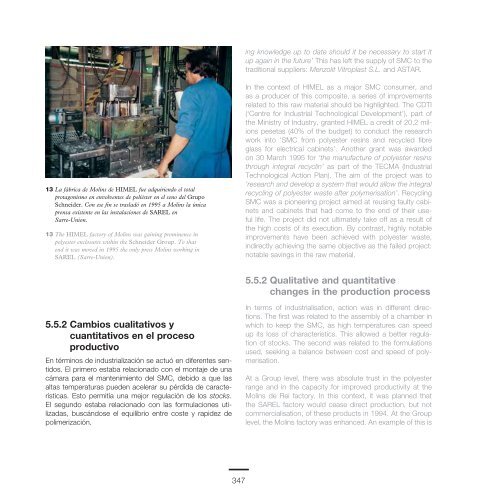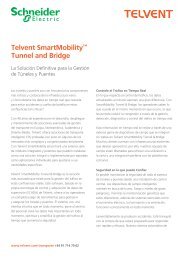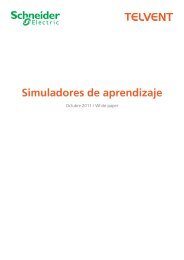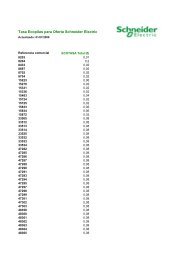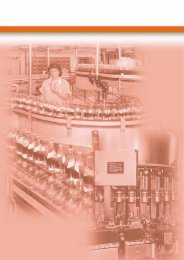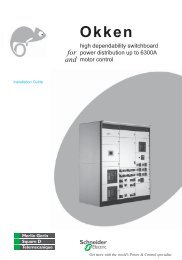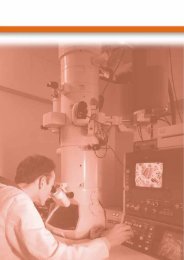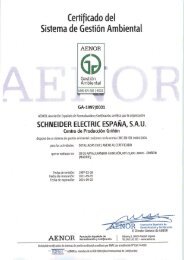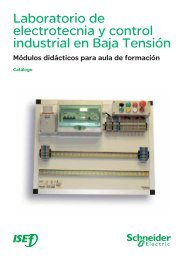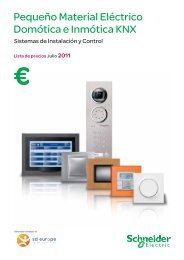ing knowledge up to date should it be necessary to start itup again in the future’ This has left the supply of SMC to thetraditional suppliers: Menzolit Vitroplast S.L. and ASTAR.13 La fábrica de Molins de HIMEL fue adquiriendo el totalprotagonismo en envolventes de poliéster en el seno del Grupo<strong>Schneider</strong>. Con ese fin se trasladó en 1995 a Molins la únicaprensa existente en las instalaciones de SAREL enSarre-Union.13 The HIMEL factory of Molins was gaining prominence inpolyester enclosures within the <strong>Schneider</strong> Group. To thatend it was moved in 1995 the only press Molins working inSAREL (Sarre-Union).In the context of HIMEL as a major SMC consumer, andas a producer of this composite, a series of improvementsrelated to this raw material should be highlighted. The CDTI(‘Centre for Industrial Technological Development’), part ofthe Ministry of Industry, granted HIMEL a credit of 20,2 milionspesetas (40% of the budget) to conduct the researchwork into ‘SMC from polyester resins and recycled fibreglass for electrical cabinets’. Another grant was awardedon 30 March 1995 for ‘the manufacture of polyester resinsthrough integral recyclin’ as part of the TECMA (IndustrialTechnological Action Plan). The aim of the project was to‘research and develop a system that would allow the integralrecycling of polyester waste after polymerisation’. RecyclingSMC was a pioneering project aimed at reusing faulty cabinetsand cabinets that had come to the end of their usefullife. The project did not ultimately take off as a result ofthe high costs of its execution. By contrast, highly notableimprovements have been achieved with polyester waste,indirectly achieving the same objective as the failed project:notable savings in the raw material.5.5.2 Qualitative and quantitativechanges in the production process5.5.2 Cambios cualitativos ycuantitativos en el procesoproductivoEn términos de industrialización se actuó en diferentes sentidos.El primero estaba relacionado con el montaje de unacámara para el mantenimiento del SMC, debido a que lasaltas temperaturas pueden acelerar su pérdida de características.Esto permitía una mejor regulación de los stocks.El segundo estaba relacionado con las formulaciones utilizadas,buscándose el equilibrio entre coste y rapidez depolimerización.In terms of industrialisation, action was in different directions.The first was related to the assembly of a chamber inwhich to keep the SMC, as high temperatures can speedup its loss of characteristics. This allowed a better regulationof stocks. The second was related to the formulationsused, seeking a balance between cost and speed of polymerisation.At a Group level, there was absolute trust in the polyesterrange and in the capacity for improved productivity at theMolins de Rei factory. In this context, it was planned thatthe SAREL factory would cease direct production, but notcommercialisation, of these products in 1994. At the Grouplevel, the Molins factory was enhanced. An example of this is347
A escala de grupo existía una confianza absoluta en la gamade poliéster y en la capacidad de mejoras de productividadde la factoría de Molins de Rei. En ese contexto se decidióque la fábrica de SAREL abandonara la producción directa,que no la comercialización, de estos productos en 1994,con ello a nivel de Grupo se potenció la fábrica de Molins.Sirva como ejemplo que en 1995 se puso en marcha unaprensa proveniente de SAREL, la TCS de fabricación italiana,para incrementar capacidad de producción y reducir elnivel de subcontratación.La fábrica de HIMEL de Molins dio un importante salto ala automatización. Un primer referente fue el proceso derobotización de la producción del PLM-3. En ese sentido serealizaron importantes inversiones en los ejercicios de 1995,1996 y 1997. El primer robot se dedicaba a la fabricaciónde los fondos. En primera instancia se realizó el procesocon la supervisión de una ingeniería externa, aunque finalmentese contrató a un robótico propio: Alfons Maldonado(y más tarde, Salvador Balanyà y Josep M. Aixàs). Cadaprensada fabrica dos armarios. En los años posteriores sefueron incorporando nuevos robots hasta alcanzar los sieteactuales (2 en la P-89 destinados a los fondos pequeños dePLM-3; 1 en la P-33 para la puertas pequeñas de PLM-3; 2en la P-101 para fondos grandes; 1 en la P-51 para el PN yel último en la máquina de mecanizado de PSP).En el proceso de automatización HIMEL dispuso de unaayuda concedida por el Ministerio de Industria y Energíaen el seno del “Plan de Actuación Tecnológico Industrial”(PAUTA) con fecha de 30 de diciembre de 1996. El nombredel proyecto era de “automatización célula fabricaciónde envolventes eléctricos SMC (Poliéster)”. El objetivo era“investigar, desarrollar y diseñar una tecnología propia deautomatización del proceso, que diera solución a los problemasque tiene el poliéster actualmente de poca automatización,y por tanto permitiese rentabilizar los capitales yacomprometidos en las inversiones”. El otro eje del proyecto,al margen del robot, fue la máquina de cortar y pesar automáticay útiles de desbarbar. El proyecto de automatizar elcorte y el pesado del SMC se inició en 1996 con dos máquinaspara acabarlo de implantar totalmente en 1998. En 1997se tenía previsto la puesta en marcha de cuatro máquinasthat in 1995 a press from SAREL, the TCS of Italian manufacturewas commissioned to raise production capacity andreduce the level of subcontracting.The HIMEL factory in Molins took a major leap to automation.A first step was the process of robotisation of PLM-3production, where significant investment was made in 1995,1996 and 1997. The first robot was used to manufacture thebases. Initially, the process was carried out under the supervisionof an external engineering firm, although in the end anin-house robotics expert was hired: Alfons Maldonado, andlater Salvador Balanyà and Josep M. Aixàs. Each pressingmanufactures two cabinets. Subsequent years saw theincorporation of new robots to get to today’s figure of seven(two on P-89 used for the PLM-3 small bases, one on P-33for the PLM-3 small doors, two on P-101 for large bases,one on P-51 for the PN and the last on the PSP toolingmachine.In the automation process, HIMEL had aid granted by theMinistry of Industry and Energy as part of the ‘IndustrialTechnological Action Plan’ (PAUTA) on 30 December 1996.The name of the project was the ‘SMC (polyester) electricityenclosure manufacturing cell automation’. The aim was to‘research, develop and design a proprietary process automationtechnology which will provide a solution to the problemsthat polyester has of scant automation, and will thereforeallow a yield on the capital already committed to investment’.The other axis of the project, besides the robot, wasthe automatic cutting and weighing machine and deburringtools. The project to automate the cutting and weighing ofthe SMC started in 1996 with two machines and was fullyimplemented in 1988. It was planned to start up four automaticcutting and weighing machines in 1997. Gains of2,000 hours a year per machine were made. Parallel to this,there has been a series of improvements to reduce changetimes of moulds. Each change also requires a change ofwork zone.In 1999 and 2000, the Molins factory was extended. As aconsequence in 1999 it was installed a new press LOIRESAFE (P-33) and other more by the firm from Hernani in2001 (P-101). The press P-21 was completely reformed348


